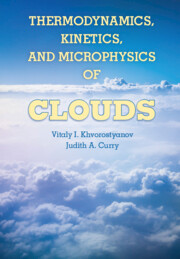Book contents
- Frontmatter
- Contents
- Preface
- 1 Introduction
- 2 Clouds and Their Properties
- 3 Thermodynamic Relations
- 4 Properties of Water and Aqueous Solutions
- 5 Diffusion and Coagulation Growth of Drops and Crystals
- 6 Wet Aerosol Processes
- 7 Activation of Cloud Condensation Nuclei into Cloud Drops
- 8 Homogeneous Nucleation
- 9 Heterogeneous Nucleation of Drops and Ice Crystals
- 10 Parameterizations of Heterogeneous Ice Nucleation
- 11. Deliquescence and Efflorescence in Atmospheric Aerosols
- 12 Terminal Velocities of Drops and Crystals
- 13 Broad Size Spectra in Clouds and the Theory of Stochastic Condensation
- 14 Analytical Solutions to the Stochastic Kinetic Equation for Precipitating Clouds
- References
- Notations
- Index
11. - Deliquescence and Efflorescence in Atmospheric Aerosols
Published online by Cambridge University Press: 05 September 2014
- Frontmatter
- Contents
- Preface
- 1 Introduction
- 2 Clouds and Their Properties
- 3 Thermodynamic Relations
- 4 Properties of Water and Aqueous Solutions
- 5 Diffusion and Coagulation Growth of Drops and Crystals
- 6 Wet Aerosol Processes
- 7 Activation of Cloud Condensation Nuclei into Cloud Drops
- 8 Homogeneous Nucleation
- 9 Heterogeneous Nucleation of Drops and Ice Crystals
- 10 Parameterizations of Heterogeneous Ice Nucleation
- 11. Deliquescence and Efflorescence in Atmospheric Aerosols
- 12 Terminal Velocities of Drops and Crystals
- 13 Broad Size Spectra in Clouds and the Theory of Stochastic Condensation
- 14 Analytical Solutions to the Stochastic Kinetic Equation for Precipitating Clouds
- References
- Notations
- Index
Summary
Phenomena of Deliquescence and Efflorescence
In Chapters 6 and 7, we considered hygroscopic growth of aerosol particles. This growth can proceed only at sufficiently high relative humidities (RHW), exceeding some critical value. At very low humidities, atmospheric aerosol particles consisting of inorganic salts are solid. As RHW increases, the particles begin to absorb water on their surface and grow by adsorption, but this growth is usually insignificant.
Aerosol transformation at increase and decrease of the relative humidity is illustrated in Fig. 11.1. When RHW reaches some threshold value, specific for each substance, the salt particle begins to deliquesce, whereby liquid patterns or patches of solution form on the surface. As the humidity further increases, these patches merge and form a thin liquid film, which gradually thickens, and then the entire solid particle dissolves and transforms into a solution drop, and its radius abruptly grows. This is the point of deliquescence D in Fig. 11.1. If the solution is homogeneous and contains only one solute, this solid–liquid phase transition is similar to the surface melting considered in Section 9.9: It occurs as homogeneous or quasi-heterogeneous surface nucleation, usually at some critical relative humidity or within a very low range of humidities. This humidity is called the deliquescence relative humidity (DRH). For example, DRH is ≈75.3% for solutions of NaCl and ≈80% for ammonium sulfate at 298 K. If a less soluble salt or another insoluble foreign substance is contained in solution—e.g., mineral dust inclusions, the solid–liquid transition may start earlier and occurs as heterogeneous nucleation within some wider range of humidities as indicated by the curve with squares in Fig. 11.1 (Richardson and Snider, 1994; Tang, 1997; Oatis et al., 1998; Onasch et al., 1999, 2000). After deliquescence occurred, further hygroscopic growth is possible with increasing humidity as described in Chapters 6 and 7 and as indicated by the upward arrow in Fig. 11.1 at Sw ≥ 0.8.
- Type
- Chapter
- Information
- Thermodynamics, Kinetics, and Microphysics of Clouds , pp. 547 - 576Publisher: Cambridge University PressPrint publication year: 2014
- 3
- Cited by



